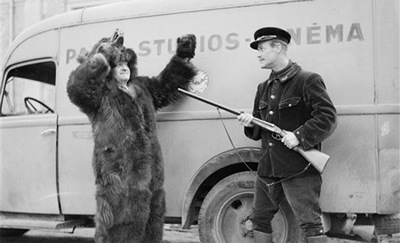The Rules of the Game (1939)
 Written and Directed by Jean Renoir.
Written and Directed by Jean Renoir.
Even though it was poorly reviewed and lost money when it was released in 1939, Renoir's The Rules of the Game is widely considered to be his greatest work.
Renoir had several previous successful films and this allowed him to establish his own production company, Nouvelle Edition francais (NEF), based on the United Artists model. However, Rules was the only film the company ever made.
Made right on the eve of WWII, Rules was based on classic styles from French comic plays. Renoir drew his plot largely from Alfred de Musset's Les Caprices de Marianne, and Beaumarchais' Le Mariage de Figaro. The movie begins with a quote from Le Mariage de Figaro. The film is intended as a comedy but Renoir also later said that he made the film to illustrate the expression "We're dancing on a volcano." He also said that the film was to be "a precise description of the bourgeois of our age." With this, he continues a theme he had explored in earlier films: the collapse of the old social order. Renoir viewed the bourgeois as trapped in social roles that were increasingly empty and meaningless.
Rules was, to some degree, a Renoir family enterprise. Jean R wrote, directed, and acted in the film. His brother Claude was one of the principals of NEF, his other brother Pierre was supposed to play one of the principal parts, and his son Alain was one of the camera operators.
Starring:
Nora Gregor (Christine de la Chesnaye), (1901-1949): Gregor had been a stage actor in Austria and had appeared in several films. She and her husband, an Austrian nobleman and nationalist/fascist politician, fled after Hitler anexed Austria in 1938 (Gregor was Jewish, her husband was far right-wing but anti German). Gregor and her husband fled to Argentina in 1942. She appeared in only one film after Rules.
Marcel Dalio (Robert de la Chesnaye) (1899-1983): Dalio was born Israel Moshe Blauschild (His parents were Romanian Jewish immigrants to France). He also played in Renoir's Grande Illusion (le lieutenant Rosenthal, one of the key characters). He went on to become a very well known character actor (over 175 total film/TV acting credits both in US and France). When the Nazis invaded France, Dalio fled. Actually, his story has some overlap with the main story of Casablanca, a film in which both he and his wife appeared. In 1939, Dalio married the French actress Madeline Lebeau (1923-2016). When the Nazis invaded, the couple fled, by borrowed car and freight train to Lisbon, Portugal. There they were stuck waiting for... yup, letters of transit.* They eventually bribed an embassy official to provide the letters authorizing them to travel to Chile. They got as far as Mexico City when it was discovered the the letters were fake. Dalio and Lebeau quickly applied for asylum in numerous countries. It was Canada that eventually allowed them in. From there, through the efforts of American friends, he eventually came to Hollywood. Meanwhile, back in France, the Nazis used stills from Dalio's pictures to create a composite image of a "typical Jew" which they posted around Paris, instructing the citizens to alert the authorities should they see anyone who looked like that. Dalio's mother and his sisters were unable to escape and all were murdered in Auschwitz. Dalio and Lebeau both had long careers after they escaped the Nazis. As I mentioned, both appeared in Casablanca (Dalio as Emile the croupier, and Lebeau as Yvonne, Rick's mistress). Dalio also played across from Bogart in To Have and Have Not (1945). He appared in many other films both in the United States and in France. Here he is in a famous scene in Catch-22 (1970):
Lebeau and Dalio didn't stay married long. They separated in 1942. Lebeau appeared in many films in the 1950s and 1960s. If you watched the Casablanca scene on the music page, you'll recognize Lebeau. Here's how she looks in that scene:

When Lebeau died in 2016 she was the last surviving credited cast member of Casablanca.
Robert Toutain (Andre Jurieux), (1905-1977): Toutain appeared in numerous films between 1924 and 1977. Of note is that he really was an aviator (at least as a hobby). He was trained as an acrobat and often took stuntman roles.
Mila Parely (Genevieve de Marras), (1917-2012): Franco-Polish actor known for this role and for her role in Jean Cocteau's Beauty and the Beast (1946). Also noteworthy: she was engaged to Jean Marais, who also starred in Beauty and the Beast and who was, more or less openly, Cocteau's lover.
Jean Renoir (Octave): The part was originally intended for Renoir's brother Pierre but Renoir himself ended up playing it.
Next: Italian Neo-realism
 Film Reviews
Film Reviews
A perceptive analysis from The Fim Sufi (2010) Required
A brilliant review and instructions for viewing the film from Norman Holland. (Norman Holland (1927-2017) was one of the most important American literary critics of the 20th century).
 Of course, if you haven't seen Casablanca you really should. It's still a classic (and comes in at number 42 on the BFI Sights and Sounds poll). The plot revolves around letters of transit that will allow two people to escape from Nazi controlled Casablanca to Lisbon, and then to a place not occupied by the Nazis.
Of course, if you haven't seen Casablanca you really should. It's still a classic (and comes in at number 42 on the BFI Sights and Sounds poll). The plot revolves around letters of transit that will allow two people to escape from Nazi controlled Casablanca to Lisbon, and then to a place not occupied by the Nazis.